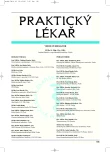Consumption of medical care in children till the age of five
Authors:
J. Balharová; I. Klimešová
Authors‘ workplace:
Oddělení preventivní a sociální pediatrie Ústavu sociálního lékařství a veřejného zdravotnictví, LF MU v Brně Vedoucí: Prof. MUDr. Jan Holčík, DrSc.
Published in:
Prakt. Lék. 2006; 86(4): 198-203
Category:
Of different specialties
Overview
The authors analysed consumption of medical care in Brno and Znojmo children from the birth till the age of five in the frame of ELSPAC study. Comparison of results found in these different localities provided the possibility to find out whether or not there are some differences in consumption of medical care in children living in big city, in a country and in small town. The authors also explored the differences in consumption of medical care between boys and girls and development of the consumption according to the age from the birth till the age of five.
The set is created by 7132 children born within the years 1991 and 1992, 5408 of them had the permanent habitation in Brno and 1724 children in Znojmo district. Greater number of both curative and preventive visits as well as that of hospitalisations in children till the age of three occured in Brno. The most frequent reason for curative visits in the youngest age cathegories are respiratory diseases, followed by diarrhoeal diseases. Infants were hospitalised the most often, and were followed by five years old children. Boys showed permanently higher consumption of medical care – they needed more curative visits as well as hospitalisations. Boys also showed higher consumption of medical care due to accidents.
Key words:
Child, medical care, preventive care, curative care, ELSPAC
Labels
General practitioner for children and adolescents General practitioner for adultsArticle was published in
General Practitioner

2006 Issue 4
Most read in this issue
- A rare tunnel syndrome in the lower extremities.
- Prognostic and predictive factors in prostate cancer
- Social differences and population health.
- Psychotherapy in neuroimagins methods of CNS
